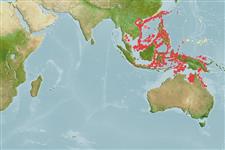>
Eupercaria/misc (Various families in series Eupercaria) >
Cepolidae (Bandfishes) > Cepolinae
Etymology: Acanthocepola: Greek, akantha = thorn + Latin, cepulla, cepa = onion.
More on author: Valenciennes.
Environment: milieu / climate zone / depth range / distribution range
البيئة
بحري القاع; نطاق العمق 80 - 100 m (Ref. 43239). Temperate; 26°N - 20°S, 72°E - 149°E (Ref. 56298)
Indo-Pacific: India to Gulf of Papua; north to Japan; south to Australia.
الحجم / وزن / العمر
Maturity: Lm ? range ? - ? cm
Max length : 50.0 cm TL ذكر/ مختلط الجنس; (Ref. 559)
الأشعة الظهرية الناعمة (المجموع) : 102 - 104; أشعه شرجية لينه: 105 - 107.
Adults pair and feed in loose groups; juveniles gather in small groups on deep sand slopes, usually in current-prone areas (Ref. 48635). Occurs in mud bottoms 15-100 m deep (Ref. 90102). Commonest member of the Japanese cepolid fishes. Caught by trawl net from sandy or muddy bottoms. Used mainly for fish cake. (Ref. 559 and 637). Minimum depth of 15 m reported from Ref. 90102.
Life cycle and mating behavior
Maturities | التكاثر | Spawnings | Egg(s) | Fecundities | Larvae
Masuda, H., K. Amaoka, C. Araga, T. Uyeno and T. Yoshino, 1984. The fishes of the Japanese Archipelago. Vol. 1. Tokai University Press, Tokyo, Japan. 437 p. (text). (Ref. 559)
IUCN Red List Status (Ref. 130435)
استخدامات بشرية
مصائد: تجاري
أدوات
تقارير خاصة
Download XML
مصادر علي الأنترنت
Estimates based on models
Preferred temperature (Ref.
123201): 20.2 - 26.6, mean 24 °C (based on 40 cells).
Phylogenetic diversity index (Ref.
82804): PD
50 = 0.5625 [Uniqueness, from 0.5 = low to 2.0 = high].
Bayesian length-weight: a=0.00513 (0.00222 - 0.01187), b=2.82 (2.61 - 3.03), in cm total length, based on LWR estimates for this (Sub)family-body shape (Ref.
93245).
مستوى غذائي (Ref.
69278): 3.4 ±0.4 se; based on size and trophs of closest relatives
المرونه (Ref.
120179): وسيط, الحد الزمني الأدني لتضاعف عدد أفراد المجتمع 1.4-4.4 سنة (Preliminary K or Fecundity.).
Fishing Vulnerability (Ref.
59153): Moderate vulnerability (40 of 100).
